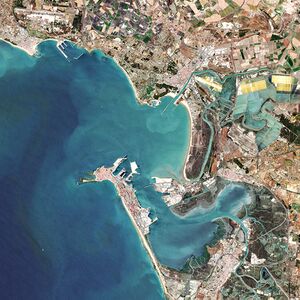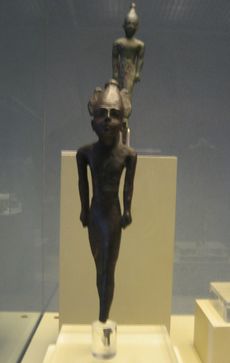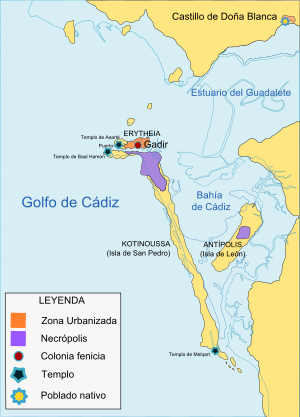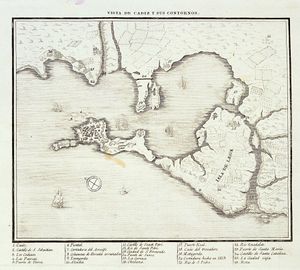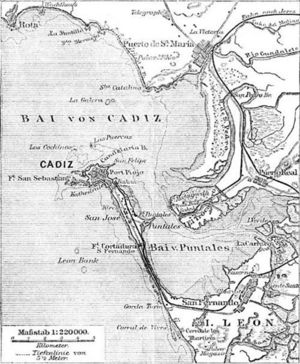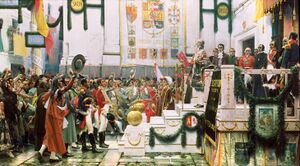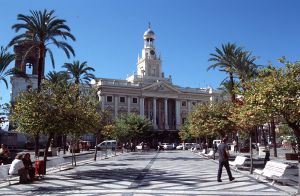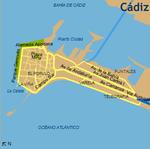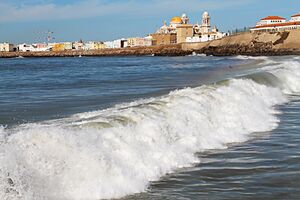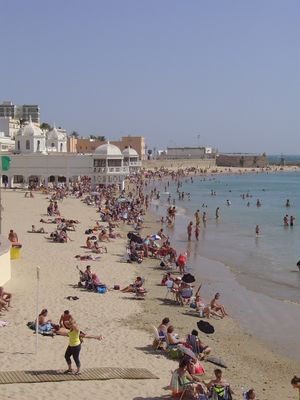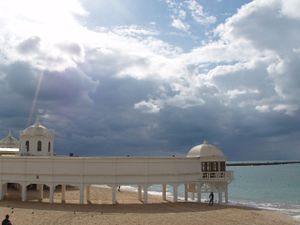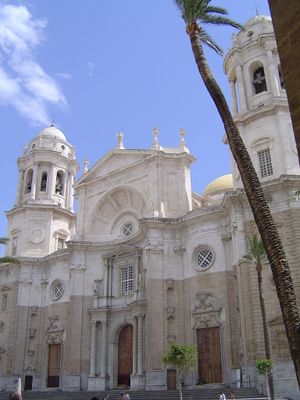قادس
Cádiz | |||
|---|---|---|---|
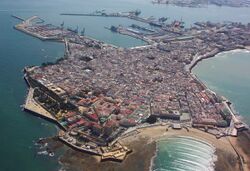 | |||
| الإحداثيات: 36°32′06″N 06°17′51″W / 36.53500°N 6.29750°W | |||
| البلد | Spain | ||
| الإقليم | أندلوسيا | ||
| المقاطعة | قادس | ||
| تأسست | الفينيقيون؛ 1104 ق.م. | ||
| الحكومة | |||
| • النوع | Ayuntamiento | ||
| • الكيان | Ayuntamiento de Cádiz | ||
| • العمدة | José María González (Adelante) | ||
| المساحة | |||
| • الإجمالي | 12٫10 كم² (4٫67 ميل²) | ||
| المنسوب | 11 m (36 ft) | ||
| التعداد ()[1] | |||
| صفة المواطن | Gaditano (m), Gaditana (f) | ||
| منطقة التوقيت | UTC+01:00 (CET) | ||
| • الصيف (التوقيت الصيفي) | UTC+02:00 (CEST) | ||
| Postal code | 11001 | ||
| Dialing code | (+34) 956 | ||
| Patron Saints | Saint Servando & Saint Germán Our Lady of the Rosary | ||
| الموقع الإلكتروني | www | ||
| |||
| Click on the map for a fullscreen view | |||
قادس واحدة من أعرق المدن الإسبانية الساحلية في جنوب الأندلس وهي عاصمة مقاطعة قادس ومبنية على شبه جزيرة ضيقة وطويلة تمتد إلى داخل خليج.
Cádiz, one of the oldest continuously inhabited cities in Western Europe, with archaeological remains dating to the 12th century BC,[2][3][4][5] was founded by the Phoenicians.[6] In the 18th century, the Port in the Bay of Cádiz consolidated as the main harbor of mainland Spain, enjoying the virtual monopoly of trade with the Americas until 1778. It is also the site of the University of Cádiz.
Situated on a narrow slice of land surrounded by the sea‚ Cádiz is, in most respects, a typically Andalusian city with well-preserved historical landmarks. The older part of Cádiz, within the remnants of the city walls, is commonly referred to as the Old Town (Spanish: Casco Antiguo). It is characterized by the antiquity of its various quarters (barrios), among them El Pópulo, La Viña, and Santa María, which present a marked contrast to the newer areas of town. While the Old City's street plan consists of narrow winding alleys connecting large plazas, newer areas of Cádiz typically have wide avenues and more modern buildings. In addition, the city is dotted with numerous parks where exotic plants flourish, including giant trees allegedly brought to Spain by Columbus from the New World.
الاسم
Very little remains of the Phoenician language, but numismatic inscriptions record that they knew the site as a Gadir or Agadir (Phoenician: 𐤀𐤂𐤃𐤓, ʾGDR),[7] meaning "The Wall", "The Compound", or (by metonymy) "The Stronghold".[8] Borrowed by the Berber languages, this became the agadir (Tamazight: "wall"; Shilha: "fortified granary") common in North African place names.[9] (The Moroccan city Agadir shares a similar etymology). The Carthaginians continued to use this name and all subsequent names have derived from it. The Greek cothon refers to a Carthaginian type of fortified basin that can be seen at ancient sites such as Motya.
Attic Greek sources hellenized Gadir as tà Gádeira (باليونانية قديمة: τὰ Γάδειρα), which is neuter plural. Herodotus, using Ionic Greek, transcribed it a little differently, as Gḗdeira (Γήδειρα). Rarely, as in Stephanus of Byzantium's notes on the writings of Eratosthenes, is the name given in the feminine singular form as hè Gadeíra (ἡ Γαδείρα).
In Latin, the city was known as Gādēs and its Roman colony as Augusta Urbs Iulia Gaditana ("The August City of Julia of Cádiz"). In Arabic, the Latin name became Qādis (العربية: قادس), from which the Spanish Cádiz derives. The Spanish demonym for people and things from Cádiz is gaditano.
In English, the name is pronounced variously. When the accent is on the second syllable, it is usually pronounced /kəˈdɪz/ but, when the accent is on the first syllable, it may be pronounced as /ˈkeɪdɪz/ (![]() استمع), /ˈkɑːdɪz/, /ˈkædɪz/, and similar, typically in American English.[10][11] In Spanish, the accent is always, as according to the spelling, on the first syllable but, while the usual pronunciation in Spain is النطق الإسپاني: [ˈkaðiθ], the local dialect says النطق الإسپاني: [ˈkaðis], النطق الإسپاني: [ˈkaði] or even النطق الإسپاني: [ˈka.i] instead.
استمع), /ˈkɑːdɪz/, /ˈkædɪz/, and similar, typically in American English.[10][11] In Spanish, the accent is always, as according to the spelling, on the first syllable but, while the usual pronunciation in Spain is النطق الإسپاني: [ˈkaðiθ], the local dialect says النطق الإسپاني: [ˈkaðis], النطق الإسپاني: [ˈkaði] or even النطق الإسپاني: [ˈka.i] instead.
التاريخ
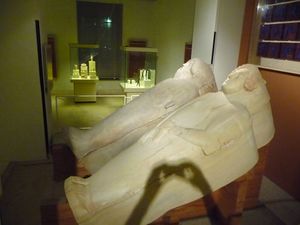
تأسست حوالي 1104 ق.م.، بإسم قادر/گادير Gadir أو أگادير Agadir على يد الفينيقيين من صور،[6][14] Cádiz is often regarded as the most ancient city still standing in Western Europe.[15] The Phoenicians established a port in the 7th century BC.[16] The expeditions of Himilco around Spain and France and of Hanno around Western Africa began there. The Phoenician settlement traded with Tartessos, a city-state whose exact location remains unknown but is thought to have been somewhere بالقرب من مصب نهر الوادي الكبير.
One of the city's notable features during antiquity was the temple on the south end of its island dedicated to the Phoenician god Melqart, who was conflated with Hercules by the Greeks and Romans under the names "Tyrian Hercules" and "Hercules Gaditanus". It had an oracle and was famed for its wealth.[17] In Greek mythology, Hercules was sometimes credited with founding Gadeira after performing his tenth labor, the slaying of Geryon, a monster with three heads and torsos joined to a single pair of legs. (A tumulus near Gadeira was associated with Geryon's final resting-place.[18]) According to the Life of Apollonius of Tyana, the "Heracleum" (i.e., the temple of Melqart) was still standing during the 1st century. Some historians, based in part on this source, believe that the columns of this temple were the origin of the myth of the "pillars of Hercules".[19]
قادس الفينيقية
وعندما يذكر سترابون جزيرة گاديرا ( قادس ) ينقل عن أهل الجزيرة قولهم بأن ثلاث هجرات كانت تمت اليها من مدينة صور، وذلك بقصد السيطرة على المضيق المخرج للبحر الأبيض المتوسط، ولاعمار الجزر التي تقع في الأطلسي، قرب هذا المخرج. وقد نسب ابناء گاديرا البعثات الثلاث إلى وحي كان يجيء للصوريين. وهذا ما كشف لعبته بوزيدونيوس، كما يذكر ذلك سترابون، حيث كشف أن الفينيقيين كانوا يخدعون البحارة الغرباء أيضاً بقولهم أن أعمدة هرقل هي حدود لنهاية الأرض.
تابوتان جميلان من العهد الفينيقي أكتشفا في مدينة قادش متحف قادس/إسبانيا
وقد بنى كتاب الاغريق الاساطير حول گاديرا هذه بفضل الغموض الذي كان يضفيه عليها الفينيقيون. ففيها، حسب رأيهم، ينابيع مسحورة ترتفع مياهها، وتهبط بعكس حركة المد، كما فيها أشجار ليست كأشجار الدنيا. وفيها تفاح من ذهب، واغنام ليست كالاغنام الاخرى. ويرى سترابو ان گاديرا هذه هي " أرضية "نفسها التي تكلم عنها الاغريقي " فريسيد "، وهي كانت مسرحاً لأسطورة الجيرون. وفي زمن هيرودت، كان سمع هذا عن نهر يدعى " أرضين " يصب في بحر الشمال الأوروبي. وقد رفض القبول بأن يكون مثل هذا النهر من تسمية غير الاغريق. واعتقد أنه كلمة اغريقية أطلقها بعض الشعراء. كما لم يستطع الاستعلام عن جزائر القصدير التي كان يجلب منها التجار الفينيقيون الكهرمان والقصدير. ولم يعرف شيئاً عن البحر الذي يحيط اوربا من الغرب والشمال. ولكن تسمية النهر " أرضين " تثبت الوجود الفينيقي هناك، رغم شك هيرودتوس بالموضوع من أساسه، في القرن الخامس ق.م.
عندما وصف سترابون كثافة سكان جزيرة گاديرا في زمنه قال " انها المدينة التي تستخدم أكبر عمارات بحرية تجارية، سواء في البحر الداخلي، أم في البحر الخارجي. ورغم أن سكانها يقيمون على جزيرة ضيقة فهم نادراً ما يضعون أقدامهم على اليابسة، ولم يبق لهم اية جزر تمدهم بالثروة. ولهذا فهم يعيشون معظم أوقاتهم في البحر. وقلائل منهم يعيشون بصورة دائمة في غاديرا أو في روما. أما عدد المواطنين وبدون هذه الحالة، يمكننا اعتباره يفوق أية مدينة أخرى، باستثناء روما. وكان منها في الجيش الروماني خمسمائة فارس، وهو رقم لم تصل اليه سوى " باتافيوم " في إيطاليا. ويذكر لنا " تيت ليف " أنها قدّمت أموالاً كثيرة لجيوش قرطاجة، وكانت قاعدة حربية للأسطول في حروب حنبعل.
وكتب سترابون يصف سكان جزيرة گاديرا فقال : " هذه الجزيرة لا تتميز بشيء عن غيرها إلا بشجاعة سكانها في الملاحة، وبعلاقتهم بالرومان، مما أعطاهم دافعاً للنجاح في جميع الميادين. وقد غدت جزيرتهم الأكثر شهرة بين جميع الجزر، رغم كونها واقعة في نهاية الأرض.
سقطت المدينة في قبضة قرطاج أثناء حملة Hamilcar Barca على أيبيريا بعد الحرب الپونيقية الأولى. Cádiz became a depot for Hannibal's conquest of southern Iberia, and he sacrificed there to Hercules/Melqart before setting off on his famous journey in 218 BC to cross the Alps and invade Italy.[20] Later the city fell to Romans under Scipio Africanus in 206 BC.[21] Under the Roman Republic and Empire, the city flourished as a port and naval base known as Gades. Suetonius relates how Julius Caesar, when visiting Gades as a quaestor (junior senator), saw a statue of Alexander the Great there and was saddened to think that he himself, though the same age, had still achieved nothing memorable.[22]
The people of Gades had an alliance with Rome and Julius Caesar bestowed Roman citizenship on all its inhabitants in 49 BC.[17] By the time of Augustus's census, Cádiz was home to more than five hundred equites (members of the wealthy upper class), a concentration rivaled only by Patavium (Padua) and Rome itself.[23] It was the principal city of the Roman colony of Augusta Urbs Julia Gaditana. An aqueduct provided fresh water to the town (the island's supply was notoriously bad), running across open sea for its last leg. However, Roman Gades was never very large. It consisted only of the northwest corner of the present island, and most of its wealthy citizens maintained estates outside of it on the nearby island or on the mainland. The lifestyle maintained on the estates led to the Gaditan dancing girls becoming infamous throughout the ancient world.[17]
Although it is not in fact the most westerly city in the Spanish peninsula, for the Romans Cádiz had that reputation. The poet Juvenal begins his famous tenth satire with the words: Omnibus in terris quae sunt a Gadibus usque Auroram et Gangen ('In all the lands which exist from Gades as far as Dawn and the Ganges...').[24]
The overthrow of Roman power in Hispania Baetica by the Visigoths in the 400s saw the destruction of the original city, of which there remain few remnants today. The site was later reconquered by Justinian in 551 as part of the Byzantine province of Spania.[25] It would remain Byzantine until Leovigild's reconquest in 572 returned it to the Visigothic Kingdom.
Under Moorish rule between 711 and 1262, the city was called Qādis, whence the modern Spanish name was derived. A famous Muslim legend developed concerning an "idol" (sanam Qādis) over 100 cubits tall on the outskirts of Cádiz whose magic blocked the strait of Gibraltar with contrary winds and currents; its destruction by Abd-al-Mumin ح. 1145 supposedly permitted ships to sail through the strait once more. It also appeared (as Salamcadis) in the 12th-century Pseudo-Turpin's history of Charlemagne, where it was considered a statue of Muhammad and thought to warn the Muslims of Christian invasion.[26] Classical sources are entirely silent on such a structure, but it has been conjectured that the origin of the legend was the ruins of a navigational aid constructed in late antiquity.[27] Abd-al-Mumin (or Admiral Ali ibn-Isa ibn-Maymun) found that the idol was gilded bronze rather than pure gold, but coined what there was to help fund his revolt.[28] In 1217, according to the De itinere frisonum the city was raided by a group of Frisian crusaders en route to the Holy Land who burned it and destroyed its congregational mosque.[29] The Moors were ousted by Alphonso X of Castile in 1262.
During the Age of Exploration, the city experienced a renaissance. Christopher Columbus sailed from Cádiz on his second and fourth voyages and the city later became the home port of the Spanish treasure fleet. Consequently, it became a major target of Spain's enemies. The 16th century saw a series of failed raids by Barbary corsairs; the greater part of the old town was consumed in a major fire in 1569; and in April 1587 a raid by the Englishman Francis Drake occupied the harbor for three days, captured six ships, and destroyed 31 others (an event which became known in England as 'The Singeing of the King of Spain's Beard'). The attack delayed the sailing of the Spanish Armada by a year.[30]
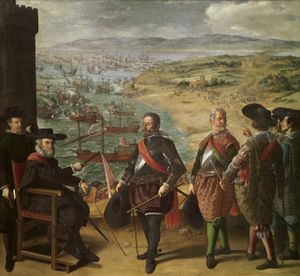
The city suffered a still more serious attack in 1596, when it was captured by an Anglo-Dutch fleet, this time under the Earls of Essex and Nottingham. 32 Spanish ships were destroyed and the city was captured, looted and occupied for almost a month. Finally, when the royal authorities refused to pay a ransom demanded by the English for returning the city intact, they burned much of it before leaving with their booty. A third English raid was mounted against the city in 1625 by George Villiers, 1st Duke of Buckingham, and Edward Cecil, but the attempt was unsuccessful. During the Anglo-Spanish War, Admiral Robert Blake blockaded Cádiz from 1655 to 1657. In the 1702 Battle of Cádiz, the English attacked again under George Rooke and James Butler, 2nd Duke of Ormonde, but they were repelled after a costly siege.
In the 18th century, the sand bars of the Guadalquivir forced the Spanish government to transfer its American trade from Seville to Cádiz, which now commanded better access to the Atlantic. Although the empire itself was declining, Cádiz now experienced another golden age from its new importance. It became one of Spain's greatest and most cosmopolitan cities and home to trading communities from many countries, the richest of which were the Irishmen.[بحاجة لمصدر] Many of today's historic buildings in the Old City date from this era.
On 12 October 1778, the right to trade with the Americas was expanded to most ports of mainland Spain, bringing the monopoly of trade hitherto enjoyed by the Port of the Bay of Cádiz to an end.[31]
أثناء الحرب الناپليونية, Cádiz was blockaded by the British from 1797 until the Peace of Amiens in 1802 and again from 1803 until the outbreak of the Peninsular War in 1808. In that war, it was one of the few Spanish cities to hold out against the invading French and their candidate Joseph Bonaparte. Cádiz then became the seat of Spain's military high command and Cortes (parliament) for the duration of the war. It was here that the liberal Spanish Constitution of 1812 was proclaimed. The citizens revolted in 1820 to secure a renewal of this constitution and the revolution spread successfully until Ferdinand VII was imprisoned in Cádiz. French forces secured the release of Ferdinand in the 1823 Battle of Trocadero and suppressed liberalism for a time. In 1868, Cádiz was once again the seat of a revolution, resulting in the eventual abdication and exile of Queen Isabella II. قرر كورتيز قادس إعادة الملكية تحت الملك أماديو بعد عامين بالضبط.
في السنوات الأخيرة، شهدت المدينة الكثير من إعادة الإعمار. وتم تنظيف وترميم العديد من الصروح والكاتدرائيات والمعالم.
المناخ
Cádiz has a hot-summer mediterranean climate (Köppen Csa) with very mild winters and warm to hot summers. The city has significant maritime influences due to its position on a narrow peninsula. Amongst any European places, Cádiz has one of the warmest winters. The annual sunshine hours of Cádiz are above 3,000h, being one of the sunniest cities in Europe. Although summer nights are tropical in nature, daytime temperatures are comparatively subdued compared to nearby inland areas such as Jerez and the very hot far inland areas in Andalucía. The average sea temperature is around 16 °C (61 °F) during the winter and around 22 °C (72 °F) during the summer.[32] Snowfall is unknown at least since 1935.[33]
| بيانات المناخ لـ قادس (1991–2020)، القصوى منذ 1955 | |||||||||||||
|---|---|---|---|---|---|---|---|---|---|---|---|---|---|
| الشهر | ينا | فب | مار | أبر | ماي | يون | يول | أغس | سبت | أكت | نوف | ديس | السنة |
| القصوى القياسية °س (°ف) | 22.6 (72.7) |
25.3 (77.5) |
29.0 (84.2) |
31.4 (88.5) |
36.5 (97.7) |
37.6 (99.7) |
40.0 (104.0) |
43.0 (109.4) |
37.8 (100.0) |
31.5 (88.7) |
27.6 (81.7) |
23.6 (74.5) |
43.0 (109.4) |
| متوسط القصوى اليومية °س (°ف) | 16.1 (61.0) |
16.9 (62.4) |
18.7 (65.7) |
20.1 (68.2) |
22.7 (72.9) |
25.4 (77.7) |
27.5 (81.5) |
28.2 (82.8) |
26.0 (78.8) |
23.5 (74.3) |
19.5 (67.1) |
16.9 (62.4) |
21.9 (71.4) |
| المتوسط اليومي °س (°ف) | 12.9 (55.2) |
13.7 (56.7) |
15.6 (60.1) |
17.1 (62.8) |
19.7 (67.5) |
22.5 (72.5) |
24.5 (76.1) |
25.2 (77.4) |
23.2 (73.8) |
20.5 (68.9) |
16.5 (61.7) |
13.9 (57.0) |
18.8 (65.8) |
| متوسط الدنيا اليومية °س (°ف) | 9.6 (49.3) |
10.5 (50.9) |
12.5 (54.5) |
14.1 (57.4) |
16.7 (62.1) |
19.6 (67.3) |
21.5 (70.7) |
22.2 (72.0) |
20.4 (68.7) |
17.5 (63.5) |
13.4 (56.1) |
10.8 (51.4) |
15.8 (60.4) |
| الصغرى القياسية °س (°ف) | 0.2 (32.4) |
−1.0 (30.2) |
2.4 (36.3) |
6.5 (43.7) |
9.2 (48.6) |
11.0 (51.8) |
16.1 (61.0) |
15.6 (60.1) |
9.6 (49.3) |
8.0 (46.4) |
3.3 (37.9) |
0.8 (33.4) |
−1.0 (30.2) |
| متوسط تساقط الأمطار mm (inches) | 65.1 (2.56) |
53.7 (2.11) |
54.9 (2.16) |
45.0 (1.77) |
30.7 (1.21) |
5.8 (0.23) |
0.1 (0.00) |
1.8 (0.07) |
30.5 (1.20) |
76.7 (3.02) |
92.1 (3.63) |
81.0 (3.19) |
537.4 (21.15) |
| Average precipitation days (≥ 1.0 mm) | 6.7 | 5.9 | 6.4 | 5.5 | 3.4 | 0.8 | 0.0 | 0.3 | 2.8 | 6.1 | 7.6 | 7.5 | 53 |
| Mean monthly ساعات سطوع الشمس | 188 | 200 | 227 | 271 | 314 | 338 | 353 | 334 | 256 | 227 | 192 | 170 | 3٬070 |
| Source: Météo Climat[34] | |||||||||||||
| بيانات المناخ لـ قادس (1981–2010)، القصوى 1955–2020 | |||||||||||||
|---|---|---|---|---|---|---|---|---|---|---|---|---|---|
| الشهر | ينا | فب | مار | أبر | ماي | يون | يول | أغس | سبت | أكت | نوف | ديس | السنة |
| القصوى القياسية °س (°ف) | 22.5 (72.5) |
25.3 (77.5) |
29.0 (84.2) |
31.4 (88.5) |
36.5 (97.7) |
37.6 (99.7) |
40.0 (104.0) |
43.0 (109.4) |
37.8 (100.0) |
31.5 (88.7) |
27.6 (81.7) |
23.6 (74.5) |
43.0 (109.4) |
| متوسط القصوى اليومية °س (°ف) | 16.0 (60.8) |
16.8 (62.2) |
18.8 (65.8) |
19.9 (67.8) |
22.1 (71.8) |
25.3 (77.5) |
27.7 (81.9) |
27.9 (82.2) |
26.3 (79.3) |
23.4 (74.1) |
19.6 (67.3) |
16.9 (62.4) |
21.6 (70.9) |
| المتوسط اليومي °س (°ف) | 12.7 (54.9) |
13.8 (56.8) |
15.5 (59.9) |
16.8 (62.2) |
19.1 (66.4) |
22.4 (72.3) |
24.6 (76.3) |
25.0 (77.0) |
23.3 (73.9) |
20.3 (68.5) |
16.5 (61.7) |
13.9 (57.0) |
18.6 (65.5) |
| متوسط الدنيا اليومية °س (°ف) | 9.4 (48.9) |
10.7 (51.3) |
12.3 (54.1) |
13.7 (56.7) |
16.2 (61.2) |
19.5 (67.1) |
21.4 (70.5) |
22.0 (71.6) |
20.3 (68.5) |
17.3 (63.1) |
13.4 (56.1) |
10.9 (51.6) |
15.4 (59.7) |
| الصغرى القياسية °س (°ف) | 0.2 (32.4) |
−1.0 (30.2) |
3.0 (37.4) |
6.5 (43.7) |
9.2 (48.6) |
11.0 (51.8) |
16.6 (61.9) |
15.6 (60.1) |
12.6 (54.7) |
8.0 (46.4) |
4.6 (40.3) |
1.5 (34.7) |
−1.0 (30.2) |
| متوسط تساقط الأمطار mm (inches) | 69.0 (2.72) |
58.5 (2.30) |
34.7 (1.37) |
45.2 (1.78) |
26.9 (1.06) |
6.7 (0.26) |
0.2 (0.01) |
1.7 (0.07) |
23.8 (0.94) |
67.3 (2.65) |
97.7 (3.85) |
92.3 (3.63) |
524 (20.64) |
| Average rainy days (≥ 1.0mm) | 6.9 | 6.4 | 4.8 | 5.6 | 3.2 | 1.0 | 0.1 | 0.2 | 2.5 | 5.6 | 7.2 | 8.1 | 51.6 |
| متوسط الرطوبة النسبية (%) | 75 | 74 | 71 | 69 | 70 | 69 | 68 | 70 | 71 | 74 | 74 | 76 | 72 |
| Mean monthly ساعات سطوع الشمس | 184 | 197 | 228 | 255 | 307 | 331 | 354 | 335 | 252 | 228 | 187 | 166 | 3٬024 |
| Source 1: Agencia Estatal de Meteorología[35] | |||||||||||||
| Source 2: Agencia Estatal de Meteorología (extremes)[36] | |||||||||||||
الشواطئ
Cádiz, situated on a peninsula,[37] is home to many beaches.
La Playa de la Caleta is the best-loved beach of Cádiz. It has always been in Carnival songs, due to its unequalled beauty and its proximity to the Barrio de la Viña. It is the beach of the Old City, situated between two castles, San Sebastian and Santa Catalina. It is around 400 متر (1،300 ft) long and 30 متر (98 ft) wide at low tide. La Caleta and the boulevard show a lot of resemblance to parts of Havana, the capital city of Cuba, like the malecon. Therefore, it served as the set for several of the Cuban scenes in the beginning of the James Bond movie Die Another Day.
La Playa de la Victoria, in the newer part of Cádiz, is the beach most visited by tourists and natives of Cádiz. It is about three km long, and it has an average width of 50 متر (160 ft) of sand. The moderate swell and the absence of rocks allow family bathing. It is separated from the city by an avenue; on the landward side of the avenue, there are many shops and restaurants.
La Playa de Santa María del Mar or Playita de las Mujeres is a small beach in Cádiz, situated between La Playa de Victoria and La Playa de la Caleta. It features excellent views of the old district of Cádiz.
وثمة شواطئ أخرى هي: Torregorda, Cortadura and El Chato.
المأكل
The gastronomy of Cádiz includes stews and sweets typical of the comarca and the city.
العمارة والعلامات المميزة
قصر سان أنطونيو
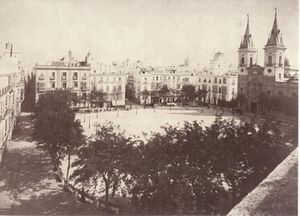
قصر الكاتدرائية والكاتدرائية
كرنڤال
السكان
| التعداد التاريخي | ||||||||
|---|---|---|---|---|---|---|---|---|
| السنة | 1999 | 2000 | 2001 | 2002 | 2003 | 2004 | 2005 | 2006 |
| تعداد | 142٬449 | 140٬061 | 137٬971 | 136٬236 | 134٬989 | 133٬242 | 131٬813 | 130٬561 |
| ±% | — | −1.7% | −1.5% | −1.3% | −0.9% | −1.3% | −1.1% | −0.9% |
| Source: INE (Spain) | ||||||||
معرض الصور
المنزل حيث ولد خوسيه ماريا پمان في 8 مايو, 1897
تمثال إميليو كاستلار إ ريپول، رئيس الجمهورية الاسبانية الأولى التي لم تعد تثير الاعجاب
Bartizanin the Castillo de Santa Catalina
المدن الشقيقة
مدن شقيقة لمدينة قادس:
 أمبالما، كولومبيا (2008)[38]
أمبالما، كولومبيا (2008)[38] بوگوتا، كولومبيا (2008)[38]
بوگوتا، كولومبيا (2008)[38] برست (فرنسا) (1986)[39][38]
برست (فرنسا) (1986)[39][38] بوينس آيرس (الأرجنتين) (1975)[38]
بوينس آيرس (الأرجنتين) (1975)[38] سبتة (اسبانيا) (2007)[38]
سبتة (اسبانيا) (2007)[38] ڤيلا سيسنروس أو الداخلة، (الصحراء الغربية) (1992)[38]
ڤيلا سيسنروس أو الداخلة، (الصحراء الغربية) (1992)[38] هويلڤا (اسبانيا)
هويلڤا (اسبانيا) لا كورونيا (اسبانيا) (2005)[38]
لا كورونيا (اسبانيا) (2005)[38] Guaduas, Colombia (2008)[38]
Guaduas, Colombia (2008)[38] Honda, Colombia (2008)[38]
Honda, Colombia (2008)[38] هافانا (كوبا)
هافانا (كوبا) Mexico City, Mexico[38]
Mexico City, Mexico[38] Móstoles, Spain (2008)[38]
Móstoles, Spain (2008)[38] Las Palmas de Gran Canaria, Spain[38]
Las Palmas de Gran Canaria, Spain[38] Puebla, Mexico[38]
Puebla, Mexico[38] San Pedro Cholula, Mexico[38]
San Pedro Cholula, Mexico[38] مدواي، المملكة المتحدة
مدواي، المملكة المتحدة مونتڤيديو (اوروگواي)
مونتڤيديو (اوروگواي) موستولس (اسبانيا)
موستولس (اسبانيا) طنجة (المغرب)
طنجة (المغرب) تورهڤييها (اسبانيا) (2003)[38]
تورهڤييها (اسبانيا) (2003)[38] Veracruz, Mexico[38]
Veracruz, Mexico[38] سان خوان، (پورتو ريكو)
سان خوان، (پورتو ريكو) San Sebastián de Mariquita, Colombia (2008)[38]
San Sebastián de Mariquita, Colombia (2008)[38] Santa Cruz de Tenerife, Spain[38]
Santa Cruz de Tenerife, Spain[38]
طالع ايضاً
المصادر
 هذه المقالة تضم نصاً من مطبوعة هي الآن مشاع: هربرمان, تشارلز, ed. (1913). الموسوعة الكاثوليكية. Robert Appleton Company.
هذه المقالة تضم نصاً من مطبوعة هي الآن مشاع: هربرمان, تشارلز, ed. (1913). الموسوعة الكاثوليكية. Robert Appleton Company. {{cite encyclopedia}}: Cite has empty unknown parameters:|1=,|coauthors=, and|month=(help); Invalid|ref=harv(help); Missing or empty|title=(help)- This article incorporates text from the public domain Dictionary of Greek and Roman Geography by William Smith (1856).
- ^
{{cite web}}: Empty citation (help) - ^ Pedro Espinosa (2006). "Found in Cádiz a wall of 3000 years". El País. Cádiz: EL PAÍS (newspaper).
- ^ "Memoria del Plan General de Ordenación Urbana" (PDF). Ayuntamiento de Cádiz. Archived from the original (PDF) on 15 December 2009. Retrieved 30 July 2009.
- ^ Phoenicians Archived 8 يونيو 2007 at the Wayback Machine according to the Iberian protohistoric architecture project.
- ^ Nash, Elizabeth (9 October 2007). "'Europe's oldest city' is found - Europe, World - The Independent". The Independent. London: INM. ISSN 0951-9467. OCLC 185201487. Retrieved 19 May 2011.
- ^ أ ب Strabo, Geographica 3.5.5
- ^ Head & al. (1911), p. 3.
- ^ "Phoenician and Punic Inscriptions", p. 141. Journal of the Royal Asiatic Society of Great Britain and Ireland. Accessed 24 July 2013.
- ^ Lipiński, Edward (2002). Semitic Languages: Outline of a Comparative Grammar. Orientalia Lovaniensia Analecta. Vol. 80. Belgium: Peeters Leeuven (published 2001). p. 575. ISBN 978-90-429-0815-4. Archived from the original on 11 October 2017. Retrieved 28 June 2008.
- ^ خطأ استشهاد: وسم
<ref>غير صحيح؛ لا نص تم توفيره للمراجع المسماةMerWeb - ^ خطأ استشهاد: وسم
<ref>غير صحيح؛ لا نص تم توفيره للمراجع المسماةAHD - ^ A. B. Freijeiro, R. Corzo Sánchez, Der neue anthropoide Sarkophag von Cadiz. In: Madrider Mitteilungen 22, 1981.
- ^ "Phoenician anthropoid sarcophagi, male (around 450-400 BC) and female (around 470 BC), Cadiz Museum, Cádiz, Cadiz". Spain is culture. Retrieved 23 December 2018.
- ^ Müller, Karl (29 June 1855). "Geographi Graeci minores". Firmin Didot – via Google Books.
- ^ Espinosa, Pedro (2007). EL PAIS. Hallado en Cádiz un muro de 3.000 años
- ^ Krensky, Stephen (1987). Who Really Discovered America?. Illustrated by Steve Sullivan. Scholastic Inc. p. 30. ISBN 0-590-40854-2.
- ^ أ ب ت Smith, William. Dictionary of Greek and Roman Geography: "Gades".
- ^ Life of Apollonius of Tyana, v. 5.
- ^ From the Life of Apollonius of Tyana: " ... the pillars in the temple were made of gold and silver smelted together so as to be of one color, and they were over a cubit high, of square form, resembling anvils; and their capitals were inscribed with letters which were neither Egyptian nor Indian nor of any kind which he could decipher. But Apollonius, since the priests would tell him nothing, remarked: 'Heracles of Egypt does not permit me not to tell all I know. These pillars are ties between earth and ocean, and they were inscribed by Heracles in the house of the Fates, to prevent any discord arising between the elements, and to save their mutual affection for one another from violation.'"
- ^ Livy, 21.21.
- ^ Livy (epitome) 33.
- ^ Suetonius, Divi Iuli, Vita Divi Iuli 7.
- ^ Strabo. Geography.
- ^ Juvenal, Satires, 10.1-2.
- ^ Evans, J. A. S. (2003). New Catholic Encyclopedia (2nd ed.). Justinian I, Byzantine Emperor: Gale. pp. 95–102. Retrieved 26 January 2017.
- ^ Turpin. Thomas Rodd, trans. History of Charles the Great and Orlando, p. 6. James Compton (London), 1812. Accessed 23 July 2013.
- ^ Fear, A.T. "The Tower of Cádiz". Faventia: Revista de Filologia Clàssica, #12-13, Vol. 1-2 (1990-1991), pp. 199–211. Accessed 23 Jul 2013.
- ^ Ahmed ibn Mohammed al-Makkari. Pascual De Gauangos, ed. & trans. The History of the Mohammadan Dynasties in Spain, Vol. I, p. 78. Routledge, 2002. Accessed 23 July 2013.
- ^ Villegas-Aristizábal, Lucas, "A Frisian Perspective on Crusading in Iberia as Part of the Sea Journey to the Holy Land, 1217–1218," Studies in Medieval and Renaissance History, 3rd Series 15 (2018, Pub. 2021): 88-149. eISBN 978-0-86698-876-6
- ^ Wes Ulm. "The Defeat of the English Armada and the 16th-Century Spanish Naval Resurgence". Harvard University personal website. Archived from the original on 7 February 2004. Retrieved 30 December 2016.
- ^ Barrientos García, Mª. del Mar (2010). "Cádiz, su puerto y su bahía: la aplicación de las leyes de libre comercio". Trocadero. Cádiz: Editorial UCA (21–22): 238. doi:10.25267/Trocadero.2010.i21.i22.14. hdl:10498/14494.
- ^ "Cádiz Sea Temperature". seatemperature.org. Retrieved 30 October 2020.
- ^ Fernando Soto. "¡NIEVE EN CADIZ! ¿CUANDO?". Retrieved 2020-10-20.
- ^ "Météo climat stats Moyennes 1991/2020 Espagne (page 1)" (in الفرنسية). Retrieved 14 June 2022.
- ^ "Standard climate values. Cádiz (1981-2010)". Retrieved 22 October 2020.
- ^ "Extreme values. Cádiz (1981-2010)". Retrieved 22 October 2020.
- ^ "Google Maps". Google Maps. 1 January 1970. Retrieved 5 May 2009.
- ^ أ ب ت ث ج ح خ د ذ ر ز س ش ص ض ط ظ ع Durio, Pablo Manuel (19 September 2009). "Cádiz tiene ya una familia más que numerosa". Diario de Cádiz.
- ^ "Les jumelages de Brest". Mairie-brest.fr. Archived from the original on 3 April 2009. Retrieved 7 July 2009.
المراجع والوصلات الخارجية
- Official City of Cádiz Homepage
- Official University of Cádiz Homepage
- Diario de Cádiz (Local Newspaper)
- Cádiz Football Club Official Homepage
- 360º Panoramic walk through the City of Cádiz
- Cádiz Province Official Tourism Homepage
- [1]
- مدينة قادس بالأقمار الصناعية من خرائط گوگل
- Pages using gadget WikiMiniAtlas
- صفحات بها مخططات
- CS1 errors: empty citation
- Harv and Sfn no-target errors
- CS1: Julian–Gregorian uncertainty
- CS1 الفرنسية-language sources (fr)
- Short description is different from Wikidata
- Articles with hatnote templates targeting a nonexistent page
- Missing redirects
- Coordinates on Wikidata
- Pages using Template:Spain metadata Wikidata without references
- Articles containing Phoenician-language text
- Pages using Lang-xx templates
- Articles containing Ancient Greek (to 1453)-language text
- Articles containing لاتينية-language text
- Articles containing explicitly cited عربية-language text
- Articles containing إسپانية-language text
- Pages including recorded pronunciations
- Articles with unsourced statements from July 2013
- CS1 errors: missing title
- Articles incorporating text from the 1913 Catholic Encyclopedia with no article parameter
- مدن اغريقية قيدمة في اسبانيا
- Ancient mints
- مدن وبلدات كرنفالات
- مدن ساحلية
- Costa de la Luz
- بلديات في قادس
- مستعمرات فينيقية في اسبانيا
- مدن مواني في اسبانيا
- مواقع رومانية في اسبانيا
- مدن اسبانيا
- مدن الأندلس
- موانئ
- مدن فينيقية
- صفحات مع الخرائط





